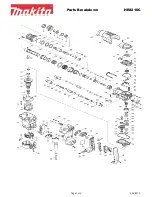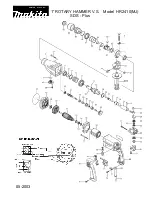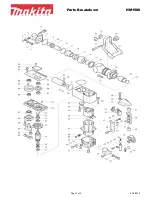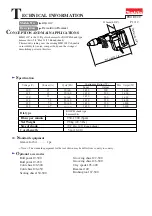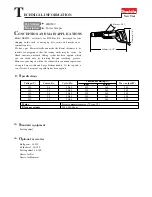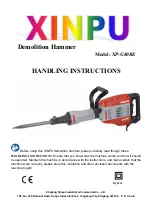
15
8.0
Operation
8.1
Clamping work pieces
To load/unload heavier work pieces, unlock arm
and rotate it out of the way. Lift work piece with
slings or other properly rated lifting equipment.
Both the box table and base surface are slotted to
accept a suitably sized T-slot clamp. Before
beginning any work on the drill press, anchor the
work piece, and the box table if used, to be certain
that work piece and/or box table will not move
when tool enters work piece.
If the box table will not be used, simply remove the
nuts at the base, and move table off using proper
lifting equipment.
Failure to properly anchor
work piece and box table could result in
damage to machine, damage to work piece, and
severe injury to machine operator. Never work
on the drill press without clamping the
materials using a T-slot system set-up.
8.2
Tool insertion
The Model J-720R uses a No. 4 Morse taper in the
spindle to secure tooling. Any drill, milling cutter, or
tool holder with an MT4 can be inserted into the
quill.
The first step in removing or
inserting any tooling is to
be absolutely certain
the machine cannot be accidentally started
during the insertion or removal operation.
The
only way to be certain of this fact is to disconnect
power to the machine. The service box should
have a cut-out switch or lever on the outside of the
box. Put the switch or lever in the OFF position
before inserting or removing tooling.
To insert tooling:
1. Verify that machine is disconnected from
power.
2. Be certain spindle is clean, free from oil, and
ready to accept the shank of any tooling.
3. Check shank of tooling to be certain tooling is
free from dirt, nicks or burrs. If nicks or burrs
are discovered, file or stone the shank until it is
smooth.
4. Be certain quill is in full UP position.
5. Slide shank of tooling into spindle until it seats.
6. Use a soft-faced mallet (such as lead, plastic,
brass, etc.) to give the tooling a sharp tap on
its tip. This will secure the tooling in the taper.
7. Re-establish power to machine. The drill is
ready to use.
To remove tooling:
1. Verify that machine is disconnected from
power.
2. Place a wood block under the tooling in the
spindle to prevent it being damaged should it
fall out during the removal process.
3. Lower quill using the feed levers until tool
removal window is exposed. Rotate spindle by
hand until removal windows align.
4. Insert tapered drift (included in toolbox) into
removal window, above the tip of tooling
shank.
5. Use a leather glove to hold the tooling with
your hand to prevent it falling from quill.
6. With your free hand, tap the tapered drift with
a hammer until tooling can be removed.
8.3
Tool Positioning over work piece
After work piece has been clamped to base or
table, position the tooling over the work piece,
using any or all of the following methods:
1. Adjusting height of arm on support column.
2. Moving drill head along arm.
3. Rotating column upon which the arm and head
are attached.
Always be certain lock
handles are tight before using drill press. Pull
on the arm handle and try to rotate handwheel
at front of head, before starting spindle. Failure
to have all locks secure may result in damage
to tooling, damage to work piece, and possible
injury to operator.
8.4
Raising/lowering radial arm
Arm movement can produce a
crushing or pinch hazard. Keep hands and
limbs clear of arm and column areas when
raising or lowering.
1. Release upper locking handle on column, by
pushing it to the left.
2. Raise or lower arm to required height using
arm/spindle control lever (see Figure 7-1). See
also
sect. 8.11.
3. When arm is at required height and no other
adjustments to spindle location are required,
tighten locking handle by pushing firmly to the
right.
Summary of Contents for J-720R
Page 9: ...9 General Features and Terminology cont Figure 5 2 ...
Page 14: ...14 7 0 Operating Controls J720R Figure 7 1 Operating Controls ...
Page 23: ...23 Figure 12 1 Figure 12 2 Figure 12 3 Figure 12 4 Figure 12 5 ...
Page 27: ...27 13 3 1 Base Column and Arm Assemblies Exploded View ...
Page 30: ...30 13 4 1 Gear Box Assembly Exploded View ...
Page 34: ...34 13 5 1 Rear Gear Box Assembly I Exploded View ...
Page 35: ...35 13 5 2 Rear Gear Box Assembly II Exploded View ...































